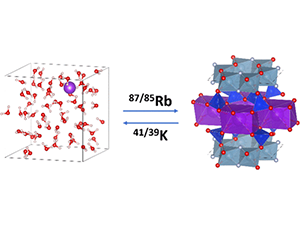Ab Initio Calculation of Equilibrium Isotopic Fractionations of Potassium and Rubidium in Minerals and Water
 ACS Earth Space Chem. 2019, 3, 11, 2601-2612
ACS Earth Space Chem. 2019, 3, 11, 2601-2612
Hao Zeng, Viktor F. Rozsa, Nicole Xike Nie, Zhe Zhang, Tuan Anh Pham, Giulia Galli, and Nicolas Dauphas
The abstract reads as follows: We used first-principle approaches to calculate the equilibrium isotopic fractionation factors of potassium (K) and rubidium (Rb) in a variety of minerals of geological relevance (orthoclase, albite, muscovite, illite, sylvite, and phlogopite). We also used molecular dynamics simulations to calculate the equilibrium isotopic fractionation factors of K in water. Our results indicate that K and Rb form bonds of similar strengths and that the ratio between the equilibrium fractionations of K and Rb is approximately 3–4. Under low-temperature conditions relevant to weathering of continents or alteration of seafloor basalts (∼25 °C), the K isotopic fractionation between solvated K+ and illite (a proxy for K-bearing clays) is +0.24‰, exceeding the current analytical precision, so equilibrium isotopic fractionation can induce measurable isotopic fractionations for this system at low temperature. These findings, however, cannot easily explain why the δ41K value of seawater is shifted by +0.6‰ relative to igneous rocks. Our results indicate that part of the observed fractionation is most likely due to kinetic effects. The narrow range of mean force constants for K and Rb in silicate minerals suggests that phase equilibrium is unlikely to create large K and Rb isotopic fractionations at magmatic temperatures (at least in silicate systems). Kinetic effects associated with diffusion can, however, produce large K and Rb isotopic fractionations in igneous rocks.
T.A.P.(performed simulations of solvated ions) was supported as part of the Center for Enhanced Nanofluidic Transport, an Energy Frontier Research Center funded by the U.S. Department of Energy, Office of Science, Basic Energy Sciences under award no. DE-SC0019112.
https://pubs.acs.org/doi/abs/10.1021/acsearthspacechem.9b00180
